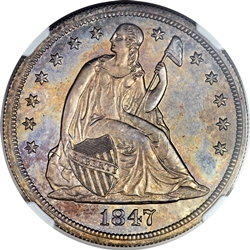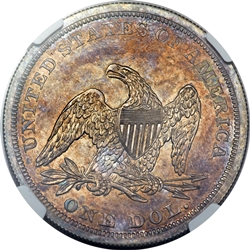 |
1847
 

|
 |
General Comments
In 1847 the Philadelphia mint was churning out huge numbers of silver coins. The silver shortage
had eased, and the mint was satisfying the pent-up demand. As a result, 1847 is one of the most
common dates from the No Motto era, with a mintage ranking of 34th out of 47. Examples are easy
to locate in virtually any grade desired. They only become rare in near-gem to gem BU, MS64 or
better.
|
| |||||||||||||||||||||
1847 Die Marriages
5 die marriages have been positively identified. Two obverse dies were paired with 4 reverse dies to strike the four business strike die pairs. None of these dies were used for proofs. One proof die marriage was issued, combining a unique obverse die with the reverse die used for almost all original proofs issued through 1854. The following table summarizes the known die marriages.
Click the links below to view the details of the die marriages.
Die Marriage |
Rarity |
Obverse Die |
Reverse Die |
Estimated Survivors |
| OC-1 | R1 | 1 | 1846 B | 1600 |
| OC-2 | R1 | 1 | A | 2150 |
| OC-3 | R3 | 2 | B | 350 |
| OC-4 | R4 | 2 | C | 150 |
| OC-P1 | R6+ | P1 | 1840 PA | 18 |
1847 Business Strike Emission Sequence
The obverse die sequences are relatively easy to determine,
as noted below:
Emission Order |
Die Marriage |
Comments |
| 1 | OC-1 | Perfect obverse in early states. A faint die crack crosses the base of the date in later states. We assumed that OC-1 is first in the sequence since the reverse die is carried over from 1846. |
| 2 | OC-2 | A faint die crack crosses the base of the date in all states. |
| 3 | OC-3 | Perfect obverse in early states. |
| 4 | OC-4 | Unfinished area under the chin has been reduced by die polishing. A faint die crack crosses the base of the date in later states, possibly in all states. |
1847 Proof Emission Sequence
With only a single die pair known the proof emission sequence is trivial.
Emission Order |
Die Marriage |
Comments |
| 1 | OC-P1 |
1847 Quick Finder Chart
The four known business strike die marriages pair two different obverse dies with four different reverses.
The obverse dies are easy to distinguish due to notably different date positions. The reverse dies present
a bigger problem. A relatively high grade is required to conclusively identify the reverse die. Fortunately,
none of the die marriages are excessively rare, so only those collectors wishing to assemble a die marriage
set or those seeking previously unknown die combinations need to worry. OC-P1 is the only known proof die
marriage. It pairs a unique obverse die with the reverse used for almost all original issue proofs from
1840 through 1854.
Die Marriage |
Obv. Die |
Rev. Die |
Right Base |
Keys to Identification |
| OC-1 | 1 | 1846 B | JR of LE | Obverse: Base of 1 is JR of LE.
Reverse: Vertical shield line 1-1 extends lightly to horizontal line 7. All 1847 die states exhibit light die cracks under ONE D and across the top of UNITED STATES. |
| OC-2 | 1 | A | JR of LE | Obverse: Base of 1 is JR of LE.
Reverse: Heavy die lines slant slightly down to the right at the top of shield recess #1. |
| OC-3 | 2 | B | R QTR | Obverse: Base of 1 is R QTR.
Reverse: Faint die lines at the top of shield recesses 1, 2, and 3. Vertical shield line 1-1 extends nearly to the top of the shield. 1-2 and 1-3 extend to horizontal line 4. All the extensions are very faint. |
| OC-4 | 2 | C | R QTR | Obverse: Base of 1 is R QTR.
Reverse: Best identified by the LACK of the markers noted above. No die lines in the upper part of recesses 1, 2, and 3. No upward extensions of the vertical shield lines. |
| OC-P1 | P1 | 1840 PA | JL of C | Obverse: A tiny but strong die dot in the gown just above the left
left of the pole. Reverse: Defects on A3. |
| Photo credits:
Obverse and reverse full photos: NGC PR65, tied for finest known, ex. Gene Gardner, from the Heritage archives. |
